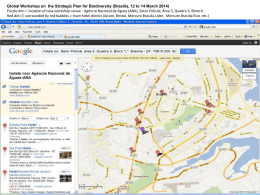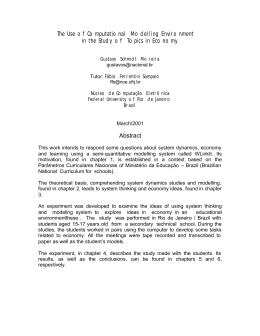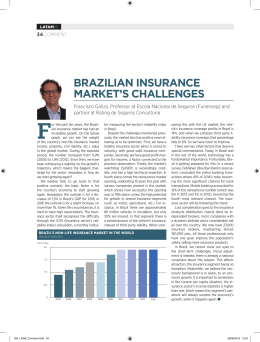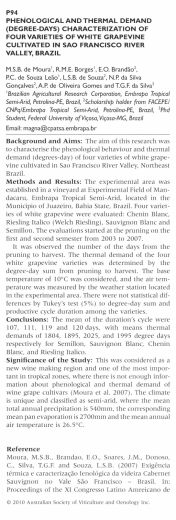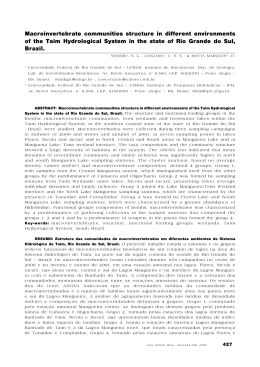Categoria 2: Comunicação de ocorrência de espécies exóticas invasoras THE FIRST OCCURRENCE OF THE ASIAN CLAM CORBICULA FLUMINAE (BIVALVIA:CORBICULIDAE) IN PARANOÁ LAKE, BRASÍLIA, BRAZIL MARTINS-SILVA, M.J.1, PIRES-JUNIOR,O.R.2, RODRIGUES, J.C.A.1, COUTINHO,M.F.2 & MIRANDA F.R.2 1 – Benthos Laboratory, University of Brasilia. 2 – Toxinology Laboratory, University of Brasilia. In a recent past, three species of Asian freshwater bivalves, Corbicula fluminea, C. largillierti and Limnoperna fortunei, have been introduced into South American inland waters, since their first report, works of new occurrences in South American region has been increased (Silva e Souza, 2004). Corbicula fluminea (Figure 1) was found for the first time in Brazil on 1978 and was believed to have been introduced to the Guaíba and Jacuí River basins in southern Brazil (Veitenheimer-Mendes, 1981). C. fluminea is a freshwater bivalve that lives buried in the sand, this clam can obstructs pipelines and irrigation canals by achieving population density above 10.000 individuals/m2 (Silva e Souza, 2004). Paranoá Lake is an artificial reservoir that was constructed in 1959 on purposes of offering recreation activities and enhancement of the microclimate in Brazil's Federal Capital, Brasilia. Paranoá Lake has an area of 37,5 Km2, it has four main creeks that provide water sources: Bananal, Torto, Riacho Fundo and Gama (Figure 2). Empty shells were discovered casually under Bragetos’ bridge (North Paranoá Lake) in October 2004 during observations of the Paranoá Lake’s water. In this locality the empty shells was very abundant (300 individuals /m2), carpeting the lake margins. Local fishermen reported that these mollusks appeared around 4-5 years ago. Shells were manually collected inside of 1 m2 area and the alive shells were captured by a D Net in February/2005. The sampled bivalves were counted and measured with an electronic digital calipter. The approximate age of C. fluminea found was calculated (Cataldo and Boltovskoy, 1998). To observe the occupation of C. fluminae the lake was traveled all over its extension (Figure 2) Suggesting that the biggest shell may belongs to the first generation, based on length we predict that the biggest shell found (39.63 mm) had about 4-5 years, supporting fishermen observations. Almost all collected shells belong to the class length (20.0-25.0 cm) The early sexual maturity, high reproductive potential and a remarkable ability to occupy different environments makes this species an aggressive invasor. These characteristics can provoke a drastic decline of native’s bivalves populations. In Paraná and Paranapanema River, Takeda et al (2000) predicted that some native molusks populations were decreasing in consequence of the presence of this asian clam. The Paranoa Lake malacofauna is poorly known, up to now only two native bivalves were found in Paranoá Lake Psidium sp and Diplodon sp. and one invasive gastropod Melanoides tuberculatus. Although we do not known if this species are overlaping theirs niches causing competition. Some studies show that this clam accumulates toxic substances in its tissues, therefore may prove a threat to human health because they are a food resource for the fish that humans eat. Silva, J.S.V and Souza, R.C.C.L (2004) Água de lastro e bioinvasão – Rio de Janeiro: Interciência 224p. Takeda, A. M.; Higuti, J.;Fujita, D. S., & Bubena, M. R., (2000) Proliferação de uma espécie de bivalve invasora, Corbicula fluminae, na área alagável do Alto Paraná (Brasil). In: Seminário Brasileiro sobre água de lastro, 1, Arrail do Cabo, p.11.m Figure 1. Corbicula fluminea collected under Brageto’s bridge of Paranoá Lake, BrasíliaDF Figure 1. Paronoá Lake localization in Brazil. Assigned area means the local of Corbicula fluminea first observation.
Download




